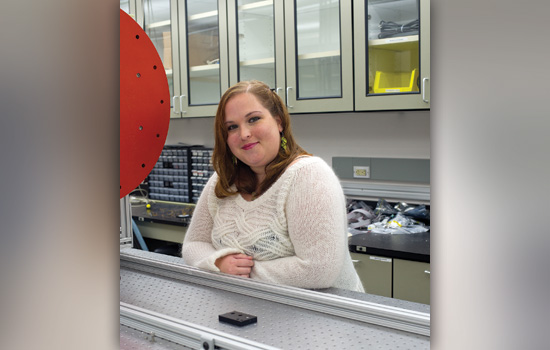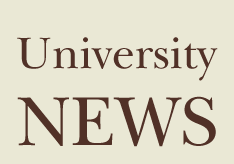Imaging science student studies tiny details of vast universe

A. Sue Weisler
Creativity—in the forms of both imaging science research or quilting—comes easily for Kim Kolb, a graduate student in the Chester F. Carlson Center for Imaging Science. Go to kimkolbquilts at www.Etsy.com to see her quilts, decorations and accessories.
by Susan Gawlowicz
Follow Susan Gawlowicz on Twitter
Follow RITNEWS on Twitter
Kim Kolb’s Ph.D. crunch culminated in a whirlwind trip to Florence, Italy, that had nothing to do with the Medici, DaVinci or the Arno River. (Well, perhaps DaVinci.)
Kolb, a graduate student in RIT’s Chester F. Carlson Center for Imaging Science, arrived in time for the Scientific Detector Workshop on Oct. 4 to share findings about an imaging system that could bring higher sensitivity and clearer vision to space missions.
Imaging arrays of Geiger-mode avalanche photodiodes, or GM-APDS, count each photon, or unit of light, carried in an “avalanche,” or a flurry of electrons. The technology was developed at Massachusetts Institute of Technology Lincoln Laboratory and advanced in partnership with RIT’s Center for Detectors in the College of Science with funding from the Gordon and Betty Moore Foundation.
Kolb spent the summer testing and characterizing the devices in the RIT Center for Detectors. In September, she and her colleagues irradiated three of the detectors at Massachusetts General Hospital Francis H. Burr Proton Therapy Center to imitate the damaging effects of space.
The posters Kolb presented in Florence, and the paper published in the conference proceedings, describe those results, which measure the usability of the radiation-damaged detectors.
Early this fall, she won a fellowship from NASA’s Earth and Space Science program to compare and contrast the new Geiger-mode photodiodes with two other single-photon detectors— linear-mode avalanche photodiodes and electron-multiplying charge-coupled devices. But most of her original work and contributions will have to do with the GM-APDS, Kolb says. Her dissertation will recommend the best single photon counting device for specific NASA applications, including the detection of exoplanets—or Earth-like planets outside our solar system—high-contrast imaging, adaptive optics and array-based LIDAR.
“Kim’s research has the potential to dramatically transform our perception of the universe and also our ability to probe the human body,” says Don Figer, director of the Center for Detectors at RIT. “She has been more deeply embedded in the center’s research than any other graduate student we have had, and she is now in a unique position in the world to do the most meaningful development of new photon-counting detectors.”
Kolb initially joined the Center for Detectors as a senior undergraduate in the microelectronics program. After gaining industry experience, she returned to RIT on a fellowship from the military contractor BAE Systems to pursue a master’s degree from the Center for Imaging Science.
“I feel really lucky,” she says. “There’s a lot of opportunity that I’ve been given that I feel I need to live up to.”
Results from Kolb’s research on the Geiger-mode photodiodes will further the center’s bid to develop technology suitable for NASA exoplanet missions and to uncover the physics behind mysterious dark matter and the universe-accelerating force dark energy.
“At the end of the day, all I’m trying to do is to count photons,” Kolb says. “It might seem tedious and small to get so embroiled in tiny details and incremental improvements, but the more photons we can collect, the more we can know. It’s about exploring the universe. It’s about exploring our home on a bigger scale.”




